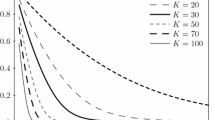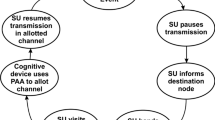Abstract
The cognitive access process based on different access schemes of the primary user in the spectrum sharing system of cognitive radio is studied. In the cognitive system with finite user population, the primary users access the licensed channels through random access, real-reservation access, pseudo-reservation access and non-random access. The cognitive users access the licensed channels without interfering the primary users. Their access process is modeled using the three-dimensional continuous Markov model. The performance analysis is presented with variation of the number of cognitive users. It is known from the simulated results that the handoff probability, the blocking probability and the forced termination probability of the cognitive users increase with the increase of the number of cognitive users. It is also found that the random access scheme has the highest handoff probability. And the real-reservation access scheme has the highest blocking probability and forced termination probability. In addition, the non-random access scheme has the maximum channel utilization.












Similar content being viewed by others
References
Clancy, T. C. (2006). Dynamic spectrum access in cognitive radio networks. Maryland: The Graduate School of the University of Maryland.
Zhang, Y., Li, Q., Yu, G., & Wang, B. (2011). ETCH: Efficient channel hopping for communication rendezvous in dynamic spectrum access networks. In Proc. IEEE Infocom (pp. 2471–2479).
Min, A., Kim, K.-H., Singh, J., & Shin, K. (2011). Opportunistic spectrum access for mobile cognitive radios. In Proc. IEEE Infocom. (pp. 2993–3001).
Tumuluru, V. K., et al. (2012). Performance analysis of cognitive radio spectrum access with prioritized traffic. IEEE Transactions on Vehicular Technology, 61(4), 1895–1906.
Chen, X., & Huang, J. (2013). Distributed spectrum access with spatial reuse. IEEE Journal on Selected Areas in Communications, 31(3), 593–603.
Zhao, M., Yin, C., & Wang, X. (2013). A novel dynamic spectrum access algorithm for cognitive radio networks. Journal of Communications and Networks, 15(1), 38–44.
Jayaweera, S., & Li, T. (2009). Dynamic spectrum leasing in cognitive radio etworks via primary-secondary user power control games. IEEE Transactions on Wireless Communications, 8(6), 3300–3310.
Simeone, O., Stanojev, I., Savazzi, S., Bar-Ness, Y., Spagnolini, U., & Pickholtz, R. (2008). Spectrum leasing to cooperating secondary ad hoc networks. IEEE Journal on Selected Areas in Communications, 26(1), 203–213.
Huang, S. H., Liu, H., & Ding, X. (2008). Opportunistic spectrum access in cognitive radio network. In IEEE international joint conference on neural networks, Hong Kong (pp. 2101–2109).
Zhu, X. R., Shen, L. F., & Yum, T. S. P. (2007). Analysis of cognitive radio spectrum access with optimal channel reservation. IEEE Communications Letters, 11(4), 304–306.
Zhang, Y. (2008). Dynamic spectrum access in cognitive radio wireless networks. In IEEE International Conference on Communications (pp. 4927–4932). Beijing: IEEE Press.
Mir, U., Merghem-Boulahia, L., Esseghir, M., Gaïti, D. (2011). A continuous time Markov Model for unlicensed spectrum access. In 2011 IEEE 7th international wireless and mobile computing, networking and communications (WiMob) conference (pp. 68–73).
Yao, Y., Feng, Z., & Miao, D. (2010). Markov-based optimal access probability for dynamic spectrum access in cognitive radio networks. In 2010 IEEE 71st vehicular technology conference (VTC) (pp. 1–5).
Tang, P. K., Chew, Y. H., & Ong, L. C., et al. (2006). Performance of secondary radios in spectrum sharing with prioritized primary access. In Military communications conference (pp. 1–7). Washington, DC: IEEE Press.
Kondareddy, Y. R., Andrews, N., & Agrawal, P., et al. (2009). On the capacity of secondary users in a cognitive radio network. In Sarnoff symposium (pp. 1–5). Princeton: IEEE Press.
Jiang, X., Zhang, Y., & Wong, K. K., et al. (2011). On partial spectrum sharing of two licensed networks using cognitive radios. In 2011 IEEE 73rd vehicular technology conference (VTC Spring), IEEE.
Jiang, X., Wong, K. K., Zhang, Y., et al. (2012). Imperfect spectrum sensing for partial spectrum-shared licensed networks. Communications IET, 6(17), 2894–2899.
Tian, Q. M., Ma, C., & Yu, G. D., et al. (2010). Analysis of cognitive radio spectrum access with finite primary users and infinite secondary users. In International conference on, Suzhou (pp. 1–5). IEEE Press.
Acknowledgments
This article was supported by Fundamental Research Funds for Central Universities (CDJXS11162236) and National Natural Science Foundation of China (No. 60872038).
Author information
Authors and Affiliations
Corresponding author
Rights and permissions
About this article
Cite this article
Feng, Wj., Jiang, R., Han, P. et al. Performance Analysis of Cognitive Radio Spectrum Access with Different Primary User Access Schemes. Wireless Pers Commun 75, 309–324 (2014). https://doi.org/10.1007/s11277-013-1364-9
Published:
Issue Date:
DOI: https://doi.org/10.1007/s11277-013-1364-9




